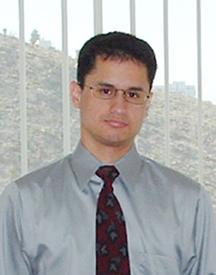Dr. José M. Hurtado Jr.
José M. Hurtado Jr., Ph.D., P.G. is Associate Professor of Geology and Graduate Advisor and Chair of the Graduate Committee in the Department of Geological Sciences at the University of Texas at El Paso (UTEP).
José earned a B.S. with honor and an M.S. in geology from Caltech in 1996. His undergraduate research involved the use of paleomagnetics to investigate the Cretaceous paleolatitude of southern British Columbia. He went on to MIT for graduate school, earning a Ph.D. in 2002. At MIT, Jose worked on the tectonic evolution of the central Nepal Himalaya and led four 1.5-month-long expeditions to the restricted the Upper Mustang region, covering over 400 km on foot at elevations up to 4500 m (1997–2000). In addition, he spent a summer doing structural geologic research via Zodiac boat in a remote fjord in East Greenland (1997).
After MIT, José spent time at the NASA Jet Propulsion Laboratory (JPL) as a postdoctoral research fellow and worked on various Earth and Mars remote sensing projects. He joined the faculty at the University of Texas at El Paso (UTEP) in the fall of 2002 as an Assistant Professor in geology and was granted tenure and promoted to Associate Professor in 2008. He currently serves as Graduate Advisor and chair of the Graduate Committee in the Department of Geological Sciences at UTEP.
He teaches courses in: physical geology; physical geography; field methods; geologic mapping; remote sensing; digital image processing; isotope geology; tectonic geomorphology; and planetary geology. He has expertise in planetary and terrestrial geology, specializing in structural geology, geomorphology, geochronology, and remote sensing. His interests also include visualization and field computing technologies for geologic fieldwork.
He is currently funded by various NASA grants to characterize the tectonics of the Bhutan Himalayas, seismic hazards in the El Paso area, and volcanic hazards in El Salvador using integrated remote sensing, geophysics, geomorphology, and geologic mapping. In support of this research he has done extensive fieldwork at San Miguel volcano, El Salvador (2007) and throughout the Kingdom of Bhutan (2004, 2009, 2010). His latest expedition to Bhutan in May 2010 included the Jhomolari region and an 18-day, 200 km trek to elevations above 5000 m.
José is heavily engaged in NASA-funded activities, including work on in-situ resource discovery, characterization, and utilization for planetary exploration. Along with several of his students, he has collaborated with the Astromaterials Research and Exploration Science group at the NASA Johnson Space Center to catalog the geologic activities conducted on the Moon by the Apollo astronauts. An interviewee for the 2009 astronaut candidate program, José is involved in various lunar geologic activities through FEAT (Field Exploration and Analysis Team; co-chair 2009-present), the Lunar and Planetary Institute, the NASA Lunar Science Institute, and the newly-created NASA/UTEP Center for Space Exploration Technology Research (co-I, 2009-present).
He has served as a member the NASA K-10 lunar robotic reconnaissance science team (June 2009; July-Aug. 2010), a member of the NASA Desert RATS science team (July-Sept. 2009, April-Sept. 2010), Lunar Electric Rover (LER) geologist-crewmember for the NASA Desert RATS field test (April-Sept. 2010), and an instructor for NASA field geologic training courses, including training of the 2009 Astronaut Candidate class (Feb. 2008; June 2009; Jan., June 2010).
José is a member of the Society for the Advancement of Chicanos and Native Americans in Science (SACNAS), the American Geophysical Union (AGU), and the Geological Society of America (GSA). He serves on the GSA Nominating Committee and as chair of the GSA Diversity Committee.
José is a licensed private pilot and has a long-standing interest in aviation, space exploration, and human spaceflight. In his spare time, he enjoys travel, camping, hiking, running, reading, and aquascaping/fishkeeping.
